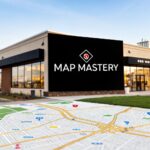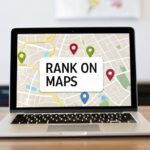When a pipe bursts at 2 AM, homeowners grab their phones and search "emergency water damage repair near me." Damage restoration SEO is how your company shows up first in that moment of crisis. It makes you the immediate, obvious choice when someone desperately needs help.
This guide breaks down exactly how to use SEO to get more emergency calls and grow your restoration business.
Why SEO is a Game-Changer for Restoration Companies
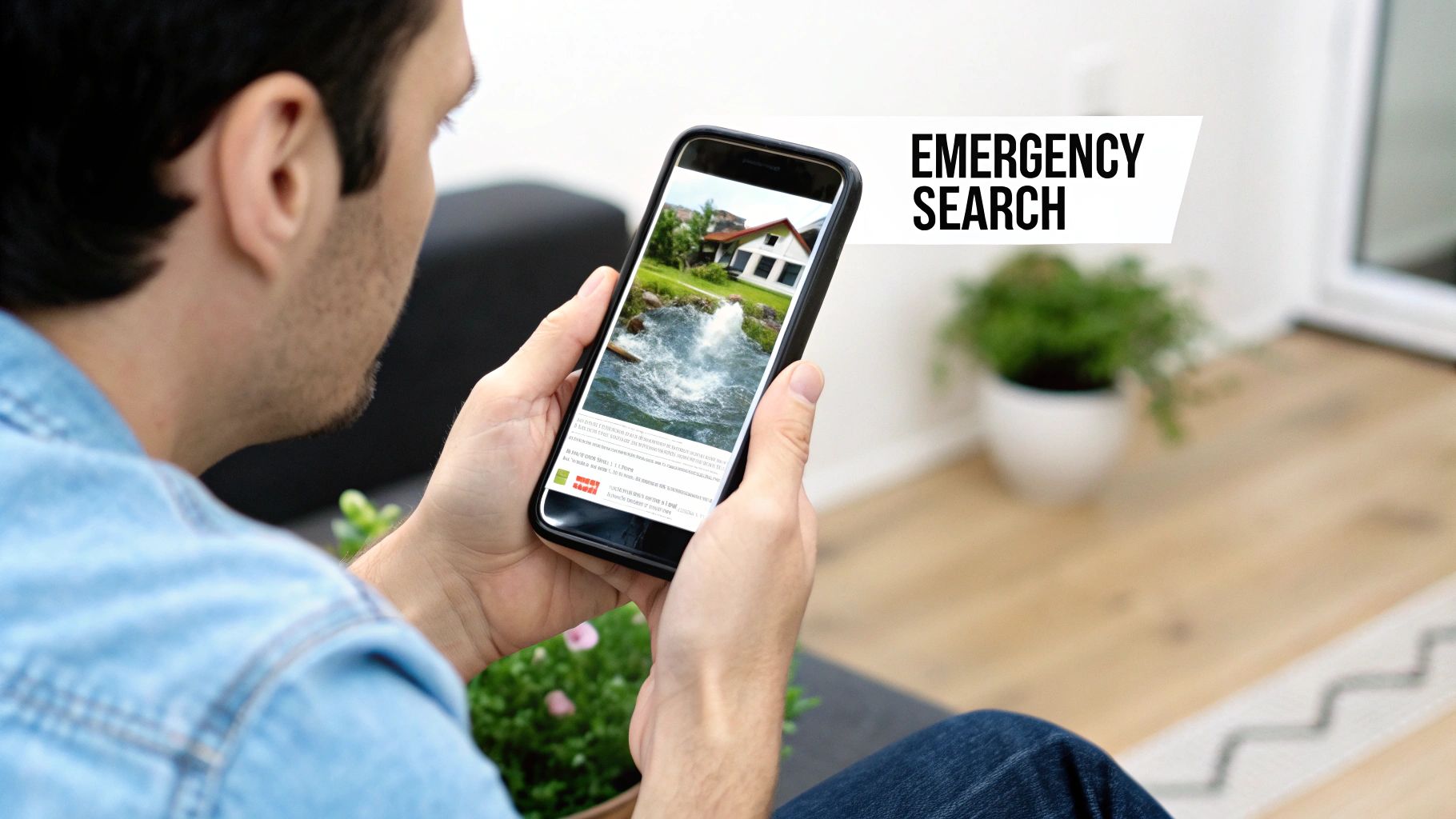
When customers need you, they're in a panic. Their basement is flooding, a kitchen fire left a mess, or they just found mold. They need a professional on-site, fast.
A strong online presence is your best lead-generation tool.
Unlike traditional ads, SEO is precise. It connects you with people who have an urgent problem and are actively looking for your exact solution. When your website ranks on the first page of Google, you’re not an ad—you’re the answer they were looking for.
Understanding the Customer's Mindset
A homeowner with a flooded living room is under a lot of stress. They aren't casually comparing quotes for weeks. They need a fast, clear way to get a professional to their house.
Your SEO strategy must be built for this high-stress situation. It’s not about keywords alone. It’s about providing instant answers, building trust quickly, and making it easy for them to call you.
The restoration industry is competitive. Data shows 64% of restoration-related inquiries now come from a mobile device, and 72% of customers reach out within 48 hours. Visibility and speed are everything.
In Short: SEO connects you with high-intent customers right when they need you, helping you capture leads before your competitors do.
SEO vs. Traditional Ads
How you spend your marketing budget matters. SEO builds long-term value that paid ads can't match.
| Factor | Damage Restoration SEO | Traditional Ads (PPC, Billboards) |
|---|---|---|
| Lead Quality | High-Intent. People actively searching for your service. | Mixed. Often interrupts people, lower urgency. |
| Cost Over Time | Decreases. An upfront investment that pays off for years. | Constant. Ads stop when you stop paying. |
| Trust & Credibility | High. Organic rankings build authority and trust. | Low. People know it's a paid ad and are often skeptical. |
| Return on Investment | Excellent. A long-term asset generating consistent leads. | Variable. Can be profitable but requires a constant budget. |
| Competitive Edge | Sustainable. Builds a long-term advantage online. | Temporary. Anyone with a bigger budget can outbid you. |
While paid ads can get calls today, a strong SEO foundation ensures you get calls today, tomorrow, and for years to come.
What is the Goal of SEO for Restoration Companies?
At its core, the goal is to make your website the most visible and trusted option in organic search results. For a restoration business, this visibility directly translates to more phone calls, more emergency jobs, and a healthier bottom line.
To learn more, it's helpful to spend some time understanding the fundamentals of SEO. It’s the blueprint for building a reliable pipeline of high-quality leads without constantly paying for ads. By ranking for the right search terms, you become the go-to local authority.
Finding Keywords That Capture Emergency Calls
To master your SEO, you have to think like a homeowner having a terrible day. When their basement is flooding, they type urgent phrases into Google because they need help now. Your keyword strategy must be built around that moment of panic.
This is about finding the right terms that lead to high-value emergency calls. You want to appear the second a potential customer thinks, "I need an expert, and I need them now." That means focusing on the specific language of a crisis.
The Three Types of Restoration Keywords
A solid keyword strategy has three main parts. Each one targets a customer at a slightly different stage, but you need all three to capture the most leads. They flow from urgent needs to specific service requests in your local area.
This infographic breaks down how these keyword types work together.
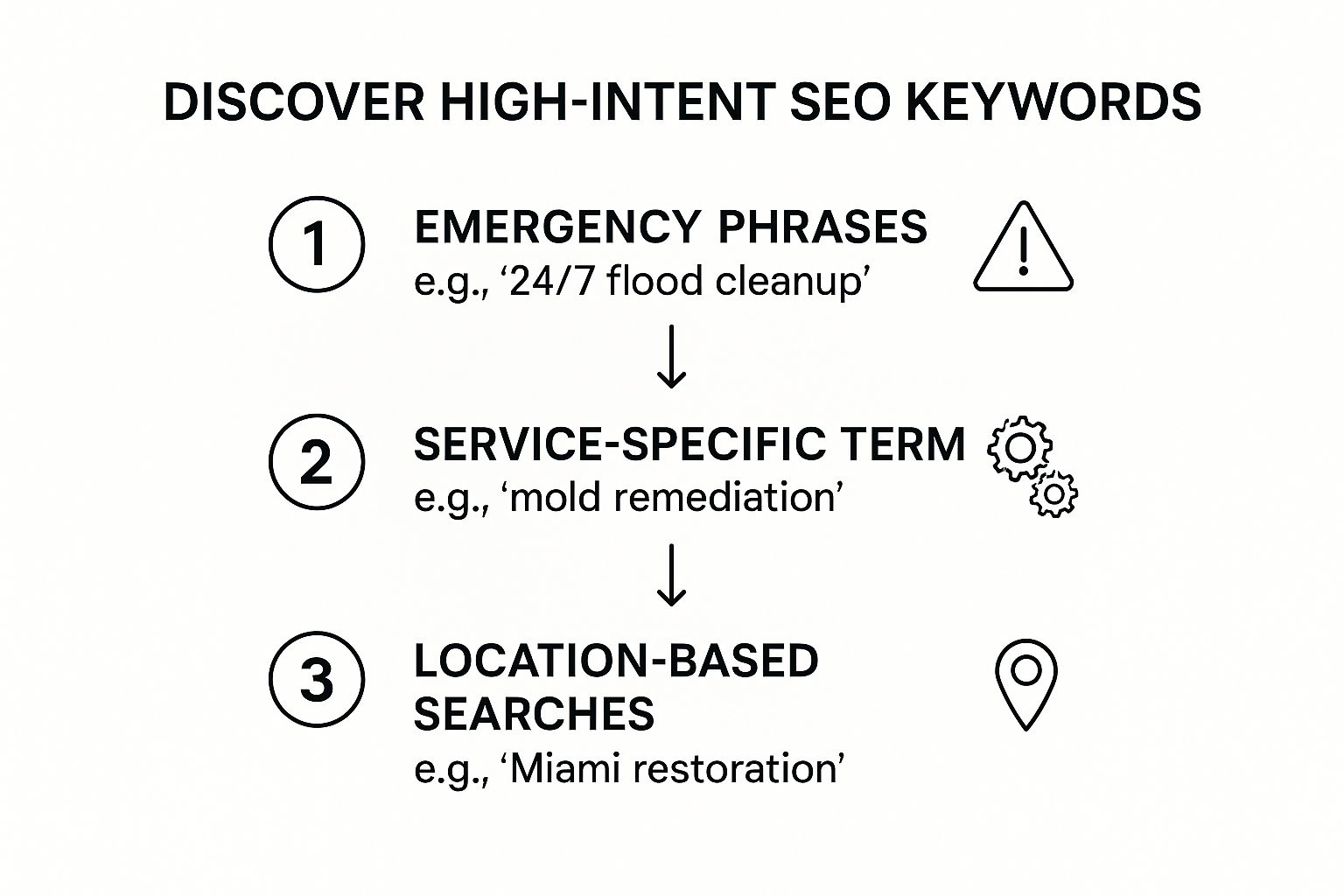
A winning strategy ensures you're visible whether someone is panicking or just searching for a specialist.
1. Emergency and High-Intent Keywords
These are the most valuable keywords. They signal urgency and almost always include words that mean someone needs help immediately. A person using these phrases is ready to hire.
- 24/7 water damage cleanup
- Emergency flood restoration near me
- Burst pipe repair hotline
- Immediate sewage backup help
These keywords have a very high chance of converting into a job.
2. Service-Specific Keywords
For situations that aren't as dire, or after the initial chaos, customers search for the exact service they need. These keywords are more descriptive and show the searcher knows what problem they have.
- Fire smoke odor removal company
- Basement mold remediation services
- Storm damage roof tarping
- Hardwood floor water damage repair
Optimizing for these terms positions you as an expert for all types of restoration jobs.
3. Location-Based Keywords
Finally, every keyword must be tied to your service area. Restoration is a local business. You have to combine your service and emergency terms with location modifiers to show up in local search results and Google Maps.
- Water damage restoration Miami
- Mold inspection company in Brooklyn
- Fire damage cleanup Phoenix AZ
In Short: The best keywords combine all three elements. A phrase like "24/7 emergency water damage restoration in Denver" is perfect. It includes urgency, a specific service, and a clear location.
People Also Ask: Finding Customer Questions
Google's "People Also Ask" (PAA) section is a free tool that shows you what real people are asking. Answering these questions on your site builds trust and attracts customers.
Here are a few common questions you should answer on your website:
- How much does water damage restoration cost?
- How to Answer: Create a blog post or FAQ page explaining the factors that affect cost, like the category of water or the size of the affected area. This builds immediate trust.
- What should you not do after a house fire?
- How to Answer: Write a simple checklist of "dos and don'ts." This positions you as a helpful authority. Add a clear call-to-action to contact your team for a professional assessment.
- Can I clean up sewage backup myself?
- How to Answer: Use this question to explain the serious health risks of biohazards. This reinforces why hiring a professional is necessary and highlights the value of your services.
How to Dominate Your Local Service Area
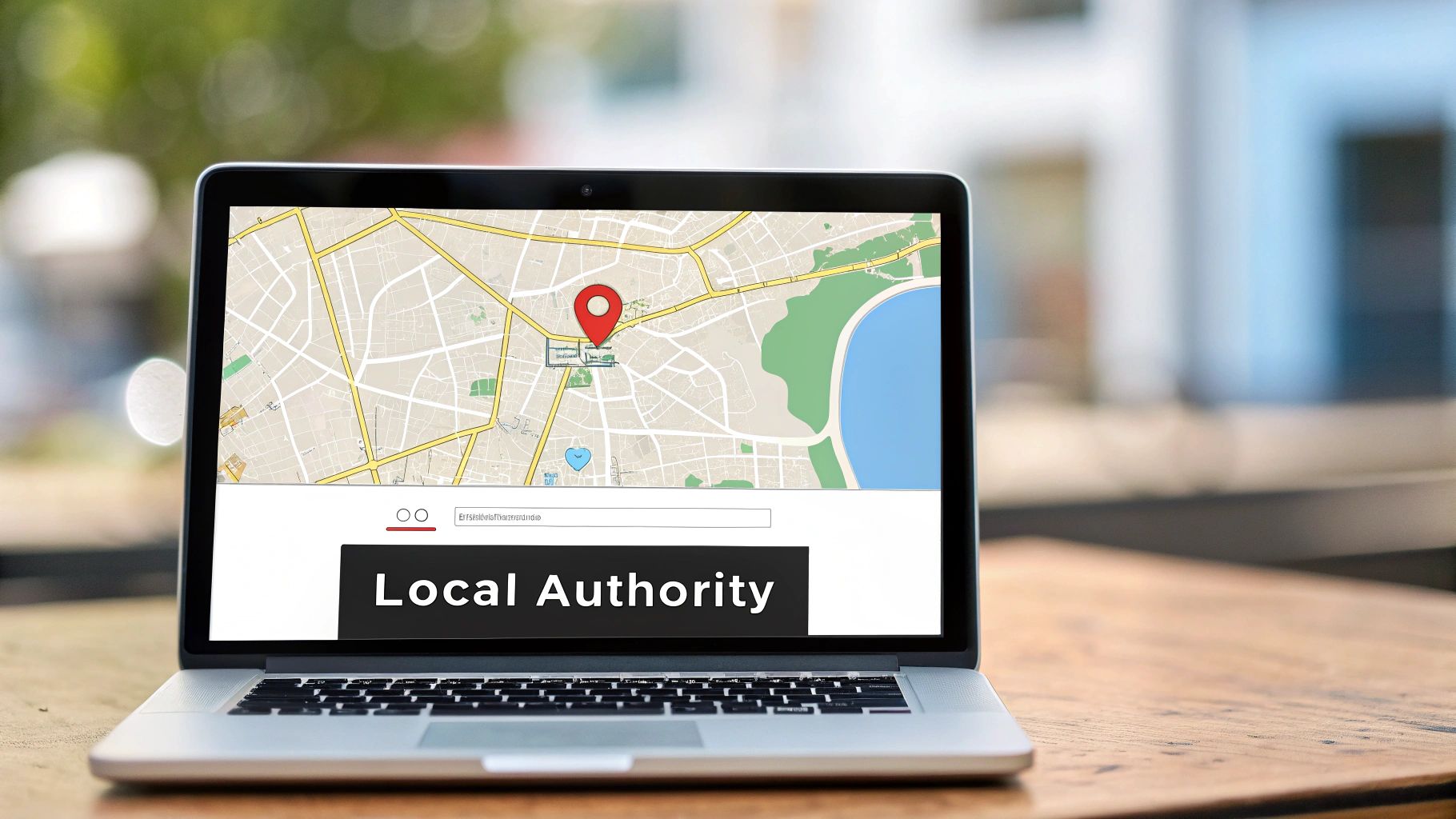
This is where you make money in damage restoration SEO. Calls that turn into jobs almost always come from local homeowners and businesses.
When you dominate your local area, you become the go-to choice when someone has an emergency. Your online presence should be the first and most professional one they find.
Your Google Business Profile is Your Digital Front Door
Your Google Business Profile (GBP) is your most important local SEO tool. It's the box that appears in Google Maps and local search results. It's often a potential customer's first impression of your business.
An incomplete profile is like a closed storefront. People will just move on.
In Short: An optimized Google Business Profile is your digital handshake. It turns a frantic searcher into a paying customer by giving them all the critical info they need at a glance.
You need to fill out every section and keep it active.
- Choose the Right Categories: Be specific. Use "Water Damage Restoration Service," "Fire Damage Restoration Service," and "Mold Remediation Service."
- Add Your Service Area: List the specific cities, towns, and zip codes you cover. This tells Google exactly where you operate.
- Upload High-Quality Photos: Show your clean, branded vans, your professional team in uniform, and your equipment. This builds instant trust.
Keep Your GBP Active to Generate Leads
An active profile signals to Google that you're an active business, which helps you rank higher.
- Use Google Posts: Treat these like free ads. Before a big storm, post about your "24/7 emergency storm response" with a direct call button.
- Enable Messaging: Many people prefer texting over calling in a stressful situation. Turn on messaging in your GBP to open another channel for leads.
- Answer Questions Proactively: Go to your own Q&A section and answer common questions. For example, post "Do you offer 24/7 emergency services?" and answer it yourself: "Yes, we are available 24/7 for all emergency water, fire, and mold situations. Call us anytime."
The Power of Consistent NAP
Your business information needs to be consistent everywhere online. This is your NAP (Name, Address, Phone number). Search engines check your NAP across sites like Yelp, Angi, and the Better Business Bureau to verify you are who you say you are.
Inconsistent information confuses Google and erodes trust. You can also use best competitive intelligence software tools to see where your competitors are listed and find new opportunities.
People Also Ask: Local SEO Questions
Here are a few more common questions from business owners.
How do I get more reviews on my Google Business Profile?
You have to ask. Once a job is done and the customer is happy, have your technician text or email them a direct link to your GBP review page. A simple script works best: "We'd be grateful if you could share your experience with a quick review. It really helps others."
Does adding photos of jobs really help?
Yes. Before-and-after photos are proof that you deliver results. Seeing that you've turned a disaster into a finished job builds a ton of confidence for a homeowner in crisis.
What are Local Services Ads?
These are the "Google Guaranteed" listings at the very top of search results. Local Services Ads (LSAs) are a game-changer for restoration companies. They put you right in front of local customers who need help now. Combining LSAs with a perfectly optimized GBP is a powerful way to capture local leads.
To dive deeper, our guide on local Maps SEO is a great next step.
Your Website: Turning Panic into a Phone Call
When a homeowner’s basement is flooding, your website has about three seconds to convince them you're the right call. Your site isn't just a brochure; it's your 24/7 emergency dispatcher.
It needs to do two things instantly:
- Show you can solve their problem now.
- Make it incredibly easy to call you.
Clarity and speed are key. A confusing, slow site is a deal-breaker for someone in a crisis.
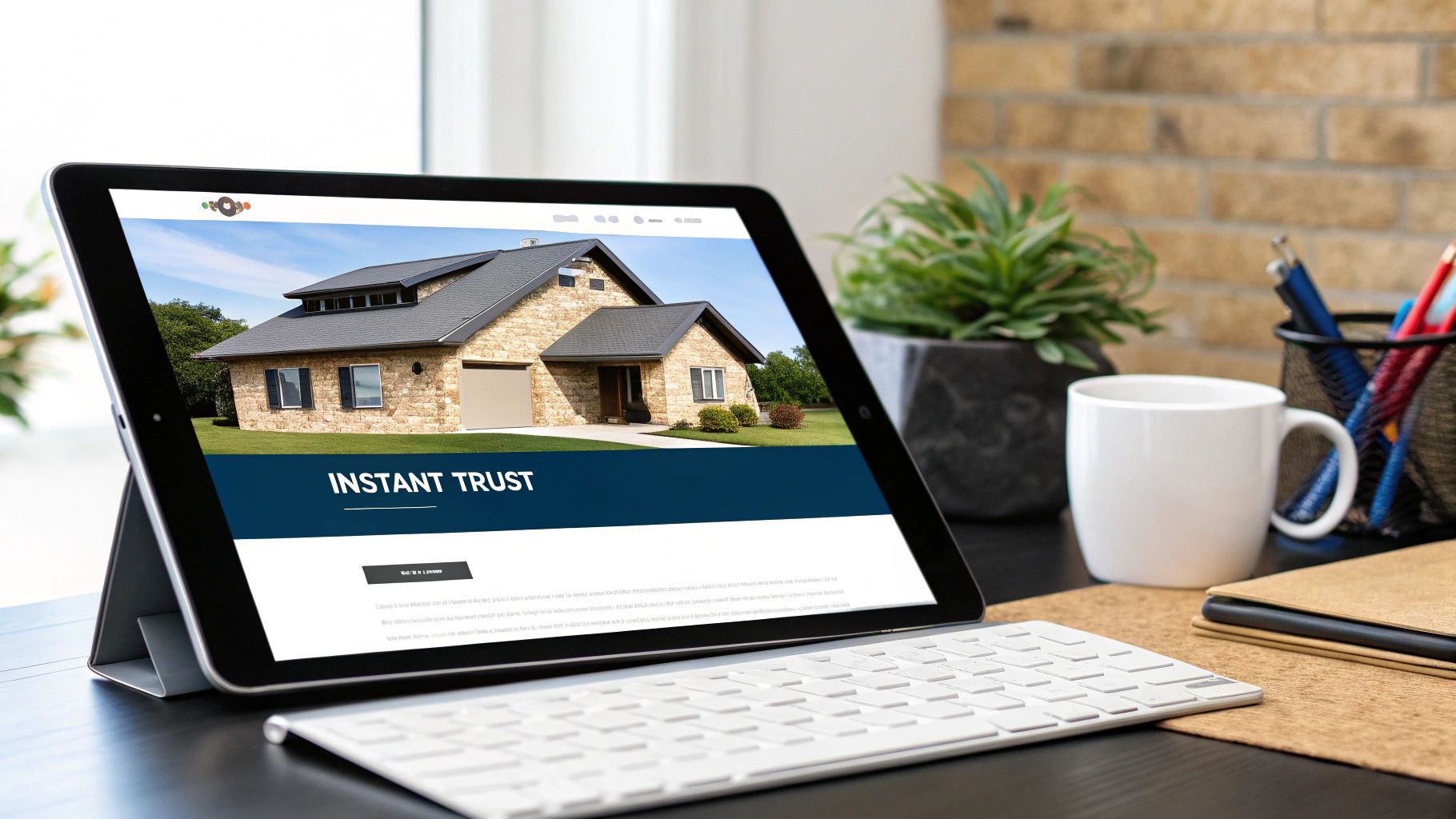
Create Dedicated Service Pages
You need a separate page for every service you offer. This is non-negotiable for SEO.
Someone searching for "fire damage cleanup Chicago" should land on a page about fire and smoke, not a general homepage.
Your must-have service pages should include:
- Water Damage Restoration: Covers burst pipes, floods, and leaks.
- Fire Damage Restoration: Details soot removal, deodorization, and repairs.
- Mold Remediation: Explains your inspection, containment, and removal process.
- Storm Damage Repair: Includes emergency board-ups, roof tarping, and debris removal.
How to Structure Each Service Page
Design your pages for action. A stressed visitor is scanning for proof and a phone number.
Every service page needs:
- A Clear Headline: Get straight to the point. "24/7 Water Damage Cleanup in Dallas" tells them they're in the right place.
- Emergency Contact Info: Your phone number should be big, bold, and in the header. Add it throughout the page with a clear call-to-action like "Call Now for Immediate Dispatch." Make sure it's clickable on mobile.
- A Simple "What Happens Next" Section: Briefly explain your process to reduce their anxiety.
- Proof You're an Expert: Add your IICRC certification logos, before-and-after photos, and customer testimonials directly on the page.
In Short: People in a crisis need an expert, not a salesperson. Your website's tone should be calm, confident, and helpful. Show them you have a plan.
A well-built website is the foundation of any good water damage contractors marketing plan.
The Power of a Before-and-After Gallery
A before-and-after gallery is your most powerful sales tool. Organize your photos by job type—water, fire, mold, etc. When a potential customer sees a disaster like theirs turned into a finished job, it builds instant trust.
Answer Questions with a Blog
A blog is a great way to attract leads and prove your expertise. Write articles that answer the frantic questions people Google during an emergency.
Blog Post Ideas That Work:
- My Pipe Just Burst: What to Do in the Next 15 Minutes
- 5 Signs of Hidden Mold You Shouldn't Ignore
- Can I Clean Up Fire Damage Myself? (Why It's a Bad Idea)
- The Water Damage Restoration Timeline: What to Expect
Every post should solve a problem and end with a clear prompt to call your team.
People Also Ask: Website Questions
Here are a few common questions about building a restoration website.
Is a mobile-friendly site really that important?
Yes, it's everything. Most emergency searches happen on a smartphone. If your site is hard to use on mobile—if the phone number isn't clickable or the text is tiny—they will leave. A responsive design is mandatory.
Should I put prices on my website?
No. Every restoration job is different, and you can't give an accurate quote without an inspection. Listing prices will only cause problems. Instead, your main offer should be a "Free, No-Obligation On-Site Estimate."
How can I make my website faster?
A slow site will cost you jobs. Boost your speed by compressing image files, using good web hosting, and choosing a clean, modern theme. Every second counts when a customer is in a rush.
Building the Trust Signals Google Loves
When a homeowner's basement is flooding, they need someone they can trust, fast. Google works the same way. To rank at the top, Google needs to see that you're a legitimate, authoritative, and trusted expert.
The real power in damage restoration SEO comes from what others say about you. This "off-page" credibility comes down to two things:
- Reviews from your customers.
- Backlinks from other local websites.
Turn Happy Customers into Powerful Reviews
Online reviews are today's word-of-mouth. A steady stream of positive feedback on your Google Business Profile is a huge ranking factor. It tells Google that real people in your area hired you and were happy with your work.
You need a system to get reviews.
- Ask at the right time: The best time to ask for a review is right after the job is done and the customer is happy.
- Make it simple: Send a direct link via text or email that opens the review form on their phone.
- Get your team involved: Train your techs to say, "We'd be grateful if you could share your experience online."
In Short: A proactive review strategy is non-negotiable. Aim for a consistent, natural flow of new reviews each month to show Google you're consistently doing great work.
What Are Backlinks for Restoration Companies?
A backlink is a link from another website to yours. Think of each backlink as a "vote of confidence." When a reputable local website links to you, it tells Google your site is a worthwhile resource.
The best links for a restoration company come from real-world relationships.
- Partner with plumbers: Plumbers are often the first call when a pipe bursts. Build relationships with local plumbing companies. Ask them to list you as their "trusted water damage partner" on their website with a link to your site.
- Sponsor a local event: Sponsoring a little league team or a community charity event is a great way to get a link from the event's website. This is a powerful local signal for Google.
- Join your Chamber of Commerce: Becoming a member usually gets you a listing with a valuable backlink, which instantly boosts your local authority.
People Also Ask: Building Trust Questions
Here are a few common questions about building trust signals.
How do I respond to a negative review?
First, take a breath. Then, respond publicly, quickly, and professionally. Thank them for the feedback, apologize that their experience wasn't perfect, and offer to take the conversation offline. A calm response can turn a negative into a positive display of customer service.
Are Yelp reviews important for SEO?
Yes. While Google reviews have the most direct impact on Google rankings, a strong profile on Yelp and other sites like Angi builds your overall online authority. A positive reputation across multiple platforms is a strong signal to Google.
What makes a backlink high-quality?
A high-quality backlink is:
- Relevant (from a plumber, roofer, or insurance agent).
- Local (from a business in your service area).
- Trusted (from the Chamber of Commerce or a local news site).
Your Top Damage Restoration SEO Questions, Answered
Let's tackle the questions I hear most often from restoration company owners. When you're doing damage restoration SEO, you're marketing to people in the middle of a stressful situation.
Here are straight, no-fluff answers to the most common questions.
How long does it take to see SEO results?
SEO requires patience. You might see a small boost from local SEO fixes in a few weeks, but a solid strategy needs about 4-6 months to start generating consistent, high-quality leads.
Think of it like building a house, not flipping a switch. The real goal is to lock in top spots for your most profitable keywords. This builds a lead pipeline that keeps your crews busy for years.
Should I do SEO or Google Ads?
You should do both, especially when starting out. They work together.
- SEO is your long game. It builds trust, authority, and organic traffic that grows more valuable over time.
- Google Ads (especially Local Services Ads) are your emergency response. They get your phone number in front of a desperate homeowner right now.
A smart strategy is to use ads for immediate leads while your SEO ramps up. We break this down in our comparison of PPC vs. SEO for restoration services. As your organic rankings improve, you can reduce ad spend, lowering your cost per job.
In Short: Use ads for now, SEO for forever. The combination gets you immediate business while building a sustainable, long-term asset.
Can I do SEO myself?
Yes, you can get started on your own. Tackling the fundamentals can make a big difference.
Here are a few things you can do today:
- Complete Your Google Business Profile: Fill out every single section. It's your most powerful local SEO tool.
- Systematize Your Reviews: Make asking for a Google review part of your process after every job.
- Build Clear Service Pages: Create dedicated pages for water, fire, and mold. Mention your city and service area in the titles and text.
However, as you grow and face more competition, hiring an expert can help you scale your results much faster.
What is a typical budget for SEO?
There is no magic number. An SEO budget depends on two things: how competitive your local market is and how aggressive your growth goals are.
Ranking for "water damage repair" in a major city like Los Angeles will require a much bigger investment than in a smaller town. A realistic monthly budget could be anywhere from $1,500 to over $5,000.
Think of SEO as an investment, not a cost. Being visible on Google is critical—that's where roughly 90% of all searches happen. Organic results are more trusted than paid ads, creating a powerful lead-generation engine. You can read more about how essential SEO is for restoration companies to grow.
Ready to stop wondering and start ranking? The team at Clicks Geek specializes in turning your website into a lead-generating machine. Let us build a custom SEO strategy that gets your phone ringing. Get in touch with us today for a free consultation.
Is Your Business Ranking in Google Maps?
Turn Google Maps into a Lead Engine w/ Clicks Geek’s AI-powered local SEO. 3,000+ clients served. Our proprietary, fully done-for-you Maps SEO system handles everything—keyword targeting, local optimization, content, reviews, and ranking strategy—automatically.



